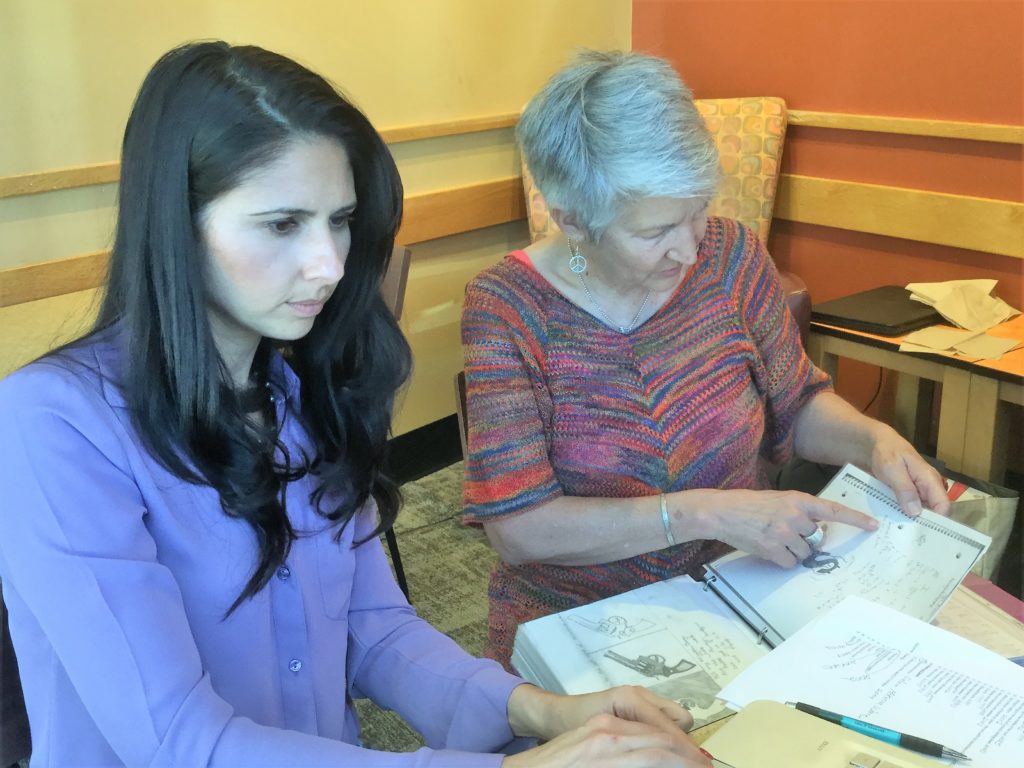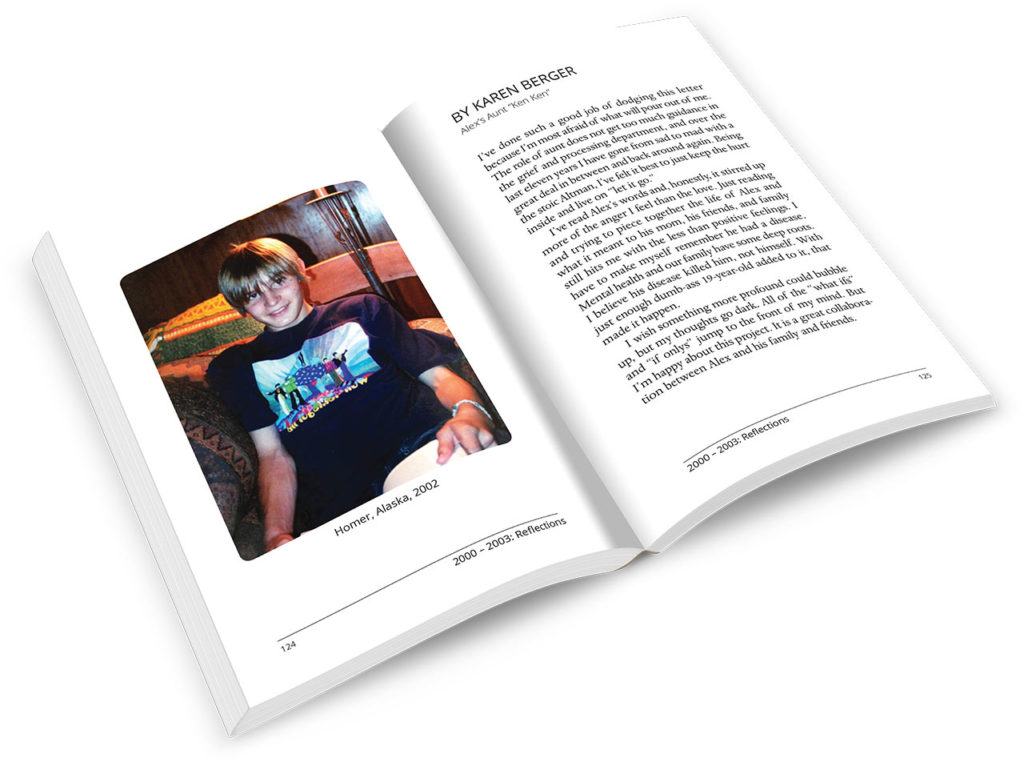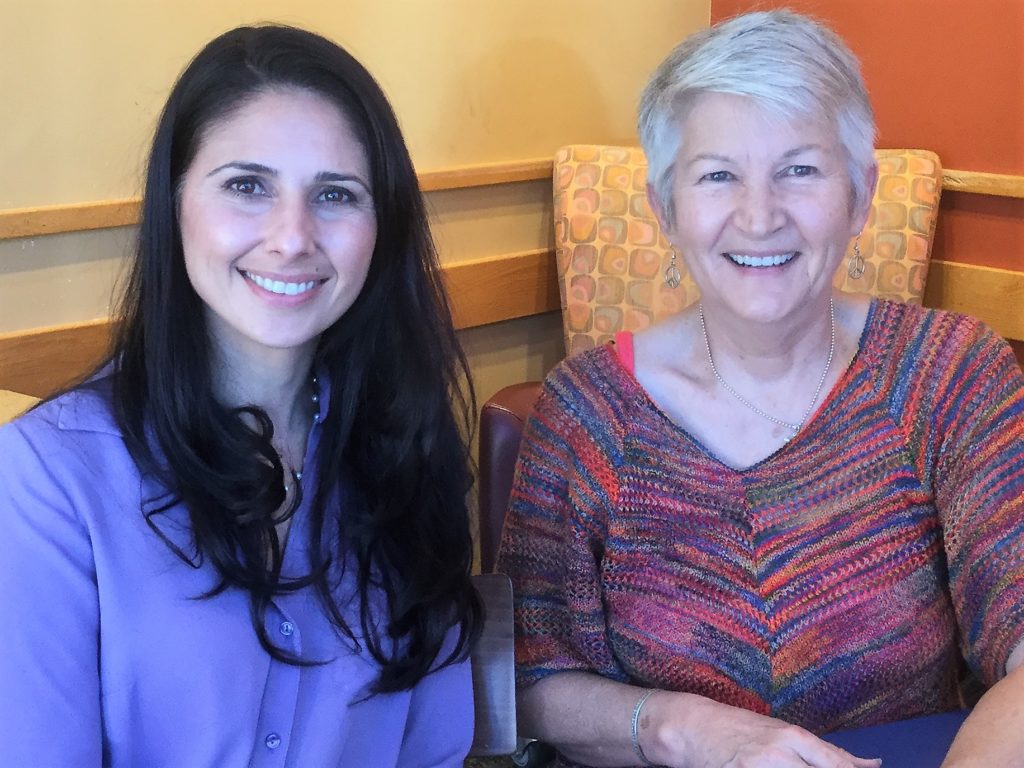Pat Stone’s life changed in 2006. That’s when her son, Alex, took his own life at just nineteen years old. In the wake of questions and grief, Pat discovered that he’d left behind a trunk of writings, poetry and drawings that revealed his inner thoughts.
Now, more than 10 years later, Pat has compiled selections from Alex’s volume of work in This Is Me: The Life and Writings of a Young Poet. It is a thoughtful gallery of photographs, school assignments, notes and poetry that retraces his steps from age seven to the night he died. In it, friends and family reminisce about the profound impact of a much-loved son, brother, nephew, uncle, friend, and—above all—free spirit.

Pat sat down with us on what would have been Alex’s 30th birthday to share what it was like to create a tribute to her son.
It’s been more than 10 years since Alex died. Why did you decide to tackle this project this year?
My motivation for this project was part mystical and part guilt.
The mystical part happened when I was spending a week in the mountains of New Mexico. I felt pulled to the fact that I was the only one who would dig through the trunk of Alex’s writings. I asked myself, “Are these writings and drawings just things that a mother will read?”
The guilty part came from knowing that it was up to me to compile Alex’s work, even if only for his family and friends.
Alex left a trunk full of journals of his writings and drawings. How did you decide what to include in the manuscript?
The first cut was made by Mark Dossert, an editor for a Houston writing center called Writespace. Mark edited a three-ring binder full of typed poems down to a version that was readable by someone other than Alex’s mother. He gave me confidence in knowing that many of Alex’s writings are useful to a wider audience than just his family and friends.
Then my publisher, Ella Ritchie, went through the edits and pulled some of them to the book. We decided to include Alex’s early years, so I was happy to include one piece of writing in particular. It’s framed in his room and says, “My dog has onle three legis.” I like this one because when Alex was born, we had two Weimaraners and two cats. So it was no surprise that his first composition would include our Weimaraner, Lucy.

Ella and Pat sift through Alex’s work in a collaboration session.
We see Alex’s work mature over time, from his elementary years to college years. We laughed at his young, 7-year-old threat to give a “nukkle sam winch” to anyone who messes with his mom. And we appreciated many of his later, darker pieces, especially “The Black Sky” and “Rest.” Do you have a favorite piece?
My favorite piece is “Be More Aware.” In it, he says, “Practice on strangers. How to be more compassionate to people we don’t know. . . . Think outside yourself.”
It hangs in the bathroom where it gets seen frequently. It shows the innate goodness and compassion he had for people who are easy to judge and discount.
You did more than compile Alex’s work. You also took the time to round up reflections from family and friends. Why was this important to you?
The reflections from Alex’s friends and teachers add to my understanding of my son. I’m not the only one that feels this way. . . . When one of his friends read Alex’s manuscript, she commented that it explained some things about Alex that she didn’t know.
I have to admit that the timing of asking for reflections couldn’t have been worse. I asked during the holiday season. I cajoled and set deadlines to try to publish his book by Alex’s 30th birthday.
But I wasn’t thinking of the emotions that I was asking them to relive. It was my project at that time. I finally realized how selfish that was and extended the deadlines to “whenever and whatever.” After the printing deadline passed his 30th birthday, I relaxed. I decided to wait even longer to gather reflections from more people.
I’m so glad I waited. Their reflections have become the heart of Alex’s book. To me, gaining understanding may be the bigger purpose of This Is Me.

The content isn’t the only thing that is meaningful. Tell us about the book cover.
Every element represents Alex. The title is a line from one of his poems. It’s bold and direct, like he was. Then we narrowed the cover image to several that we liked, and we went with one in which his face is half-hidden, like Alex was. He was private. The geometric design in the background is from one of his drawings.
The title is fitting for his work. In fact, much of Alex’s writings are dark, which made this project an emotional undertaking for everyone involved, especially for you. How did you cope?
Yes, there were many days that frustration and emotion took over.
I felt frustration over trying to make sense out of random writings and the timing of writings . . . and the never far-away emotions of what I could have done differently. The obvious pain he shows in the writings from 1997 to 2000 were the hardest to read, especially the apology note he wrote the night he died. It was also difficult to look at the photograph of him smoking a cigarette.
Even though 10 years have passed, these things bring back some old feelings like anger and disappointment. But I put them in the book because I wanted to be accurate. This was the real Alex.
Ultimately, I just kept going back to the last note Alex wrote to me: “Mom, I love you. Your son, Alex. Please be strong.”
It does take strength to publish, particularly a project like yours. Do you have any advice for others who are considering publishing a tribute to a family member or friend?
I don’t feel like I have any expertise to share. The universe just aligned for me. I had the good fortune to reconnect with Elizabeth White-Olson, the founder of WriteSpace, who opened her heart and home to me when I arrived with a 3” binder full of typed pages. She introduced me to Mark Dossert, an editor at Writespace. And then when I asked what the next step was, she showed me the Stellar Communications Houston website and said, “This one is not the least expensive route to take, but you and Alex would be in good hands.” It’s like I fell into a vat of chocolate.
Was anything about the book publishing process surprising to you?
The most surprising thing about this process has been the details. I now appreciate little things like front matter and back matter, the size of a book, the font design, and whether or not to indent text. All of these details make an enormous difference in how a book looks and how appealing it is to read.
What has been the most difficult thing and the most rewarding thing about the process of publishing Alex’s work?
The only difficult part was when I realized I had deleted the first table of contents, which was organized chronologically. The editor suggested that we rearrange the manuscript so that the tone of the work flows from light to dark. But later we reconsidered the organization and decided to return to a chronological arrangement, so I had to recreate the timeline.
The most rewarding part has been my relationship with Ella. She made me feel like Alex’s book was her only project. She was always calm, promptly responding to every question and making a point of letting me talk first. She also asked for my feedback, pointing out things that were options or personal choices with a sense that she truly valued what I thought. She understood the feelings that accompany each piece of writing as only a mother could. I’ll miss our emails and visits on the phone.
What do you hope readers will take away from This Is Me?
I hope readers who didn’t know Alex will find a kinship with some of his work. Some of his ideas are universal, and some of the topics he wrote about 10 to 12 years ago are relevant today. I hope for a greater understanding of kids labeled “troubled” or “lazy” and try to see the possibility of goodness they may be hiding.
For Alex’s family and friends, I hope This Is Me will expand their understanding of him by seeing different perspectives shown by the other reflections. His work was not widely known by even his closest friends and family. He’s grown in some people’s minds from being thought of as a “smart aleck” to “smart Alex.” For that shift in perspective, this book has served its purpose.
Thank you, Pat, for your dedication and candor throughout this interview and the entire publishing process. You’ve created quite a tribute to Alex!
We invite family, friends, and readers to check out the book announcement.

Ella Ritchie (left) is the founder of Stellar Communications Houston, a business communication and book publishing team that brings clarity, quality, and integrity to nonfiction authors, business leaders, nonprofit organizations, and federal government agencies. Connect with her on LinkedIn or Facebook, or check out the website for more information.
Pat Stone (right) is the compiler of This Is Me: The Life and Writings of a Young Poet, on behalf of her son, Alex Ware. Contact her at patstone87@gmail.com.
